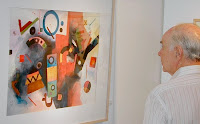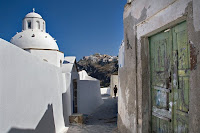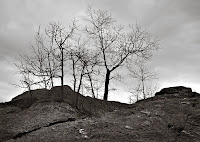
I am delighted to announce that I will be part of a three-artist exhibit entitled "Worlds Within Worlds," to be held Oct 21, 2009 - April 16, 2010 at the American Center for Physics (One Physics Ellipse, College Park, MD, 20740). The reception for the exhibit - curated by Sarah Tanguy - will be held November 16, 2009 (which falls on a Monday) between 5:30 - 7:30, with a gallery talk and presentation scheduled for 6:00pm.
If any interested readers of this blog are in the northern-DC/Maryland area around that time, and would like to see works by a wonderful sculptor (Julian Voss-Andreae), a gifted traditional artist (Cynthia Padgett), and a physicist/photographer (yours truly... I'll have 18 of my images on display, grouped into 6 categories; see below), please swing by! I plan on being at the reception on Nov 16.
A two-page fold-out brochure for the event can be downloaded here (in Adobe pdf format). It contains one of my favorite quotes by Einstein:
A two-page fold-out brochure for the event can be downloaded here (in Adobe pdf format). It contains one of my favorite quotes by Einstein:
"Where the world ceases to be the stage for personal hopes and desires, where we, as free beings, behold it in wonder, to question and to contemplate, there we enter the realm of art and science. If we trace out what we behold and experience through the language of logic, we are doing science; if we show it in forms whose interrelationships are not accessible to our conscious thought but are intuitively recognized as meaningful, we are doing art. Common to both is the devotion to something beyond the personal, removed from the arbitrary." — Albert Einstein
As the venue is clearly related to science - physics in particular - it should come as no surprise that all three artists were selected with an eye toward either the artist or his/her work having some connection to physics.
Julian Voss-Andreae, for example, is both a physicist and artist/sculptor by training. His magnificent geometric sculptures are best described as physically manifest visual forms of quantum realities. Starting from original designs of mathematical surfaces (or dynamic processes) on a computer, Julian uses his art to guide and shape these forms into a finished sculpture. Sometimes a work is created by using a particular physics-inspired process; sometimes it is created to reflect a specific physics-related property or principle. But however he creates his individual works, they are all undeniably mesmerizing and leave the viewer with a deeper appreciation of the connection between science and art. Julian's website includes a link to an informative ~8 minute YouTube video that describes his creative process (first shown on Oregon Public Broadcasting TV in December 2008).
Cynthia Padgett, while not a scientist by training, will be displaying works inspired by the exposure she has to astronomy and astronomic images through her son's study of physics. Working with a variety of media (oil, pastel, charcoal, etc), and using real astronomical photographs as conceptual spring-boards, Cynthia magically transforms empty canvases into cosmic breeding grounds for stars, entire galaxies, and the infinite mysteries of time and space. She will also be exhibiting works from her floral series, whose more "earth-centered" origin belies the drama of their own abstract cosmic rhythms.
As for me, though the subject of my photography is not confined to "metaphors of physics" (or some such thing) and actually spans quite a wide spectrum of ostensibly non-physics subject matter (from landscapes, to still lifes, to abstracts, to macros, ...), I cannot escape the fact that since I am a physicist by training - and still use my physics to solve problems in my "day job" (here is a link to one of my technical books) - I cannot help but see the world as a physicist (whatever that means;-). And that is, I suppose, the main reason I have been included in the show with these two accomplished artists. (Sarah Tanguy, the curator of the show, "confessed" that the way she found my work was by going to the Washington Project for the Arts site, of which I am a member/artist, and conducting a search for "photographer AND physicist"... hey, sometimes it pays to self-advertise!)
Julian Voss-Andreae, for example, is both a physicist and artist/sculptor by training. His magnificent geometric sculptures are best described as physically manifest visual forms of quantum realities. Starting from original designs of mathematical surfaces (or dynamic processes) on a computer, Julian uses his art to guide and shape these forms into a finished sculpture. Sometimes a work is created by using a particular physics-inspired process; sometimes it is created to reflect a specific physics-related property or principle. But however he creates his individual works, they are all undeniably mesmerizing and leave the viewer with a deeper appreciation of the connection between science and art. Julian's website includes a link to an informative ~8 minute YouTube video that describes his creative process (first shown on Oregon Public Broadcasting TV in December 2008).
Cynthia Padgett, while not a scientist by training, will be displaying works inspired by the exposure she has to astronomy and astronomic images through her son's study of physics. Working with a variety of media (oil, pastel, charcoal, etc), and using real astronomical photographs as conceptual spring-boards, Cynthia magically transforms empty canvases into cosmic breeding grounds for stars, entire galaxies, and the infinite mysteries of time and space. She will also be exhibiting works from her floral series, whose more "earth-centered" origin belies the drama of their own abstract cosmic rhythms.
As for me, though the subject of my photography is not confined to "metaphors of physics" (or some such thing) and actually spans quite a wide spectrum of ostensibly non-physics subject matter (from landscapes, to still lifes, to abstracts, to macros, ...), I cannot escape the fact that since I am a physicist by training - and still use my physics to solve problems in my "day job" (here is a link to one of my technical books) - I cannot help but see the world as a physicist (whatever that means;-). And that is, I suppose, the main reason I have been included in the show with these two accomplished artists. (Sarah Tanguy, the curator of the show, "confessed" that the way she found my work was by going to the Washington Project for the Arts site, of which I am a member/artist, and conducting a search for "photographer AND physicist"... hey, sometimes it pays to self-advertise!)
A while ago I posted a blog entry that was derived, in part, from a lecture I gave at the Smithsonian about complexity and photography. I crafted some of the images I used during the presentation (and reproduced in this blog entry) with a deliberate eye towards illustrating how one's inner world (one's feelings, thoughts, predispositions, academic training, worldview, ...) guides and shapes what one's I/eye/camera eventually reveals to the external world. As the "Worlds Within Worlds" exhibit opens, I'm making a mental note to myself to expand a bit on these ideas in future blog entries. The fundamental question being: "To what extent does the aesthetic dimension of my photography (what I choose to photograph, what my eye sees, what I work to reveal in a print, ...) owe itself - and in what way - to the fact that I am trained as a theoretical physicist?" How is what I do, as a photographer, different from what other photographers, not trained in physics, do? If there is a difference, is there an objective way of assessing what that difference is?
As for the "Worlds Within Worlds" exhibit...I will have a total of 18 images exhibited, grouped into six categories: (1) micro worlds, (2) mystic flames, (3) abstract triptychs, (4) entropic melodies, (5) rhythmic patterns, and (6) ripples & ice.
Having looked at - and marveled - at Julian's and Cynthia's works on-line (I do not know, and have not yet met either of these two gifted artists; though I am very much looking forward to meeting them at the opening in November), I am truly honored to be asked to display my humble works alongside theirs.
And I hope to see some of the readers of my blog at the reception!
And I hope to see some of the readers of my blog at the reception!


























